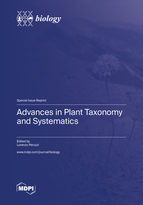Advances in Plant Taxonomy and Systematics
A special issue of Biology (ISSN 2079-7737). This special issue belongs to the section "Plant Science".
Deadline for manuscript submissions: closed (31 December 2022) | Viewed by 46796
Special Issue Editor
Special Issue Information
Dear Colleagues,
Two main problems today threaten the social and scientific recognition of systematics as a basic science crucial for all applications involving the use of organisms, including their conservation. These problems concern a) nomenclature and b) taxonomy. Nomenclature: As a consequence of increasing systematic knowledge, the scientific names of plants often change. While since about 15 years ago family-level circumscriptions (almost) became stable, species are often recombined under different genera or synonymized with others. This is perceived by taxonomy users, either in the scientific community or in wider society, as a relevant and often not understood problem. Collaborative nomenclatural and taxonomic databases are increasingly becoming widespread and authoritative, such that this problem could be easily superseded by increasing the awareness of and accessibility to such databases. Taxonomy: In general, and still today, it is much easier to describe a new species than to definitely prove that it is not worthy of recognition on systematic grounds. This is resulting in worldwide taxonomic inflation, which is also causing inconsistencies in conservation biology. This problem could be superseded only by adopting extreme caution before describing new taxa and, above all, by adopting integrated approaches to taxonomy, taking advantage of karyological, molecular, and ecological data complemented by (quantitative) morphology. Finally, another topic which is becoming more and more important, related to floristics, concerns the free availability of verified and reliable primary biodiversity data. Concerning this latter topic, relevant contributions are coming from massive herbarium digitization and citizen science.
We propose in this Special Issue to highlight the state of the art of current taxonomic and systematic research as well as its fundamental contribution to plant science and biology in general.
Prof. Dr. Lorenzo Peruzzi
Guest Editor
Manuscript Submission Information
Manuscripts should be submitted online at www.mdpi.com by registering and logging in to this website. Once you are registered, click here to go to the submission form. Manuscripts can be submitted until the deadline. All submissions that pass pre-check are peer-reviewed. Accepted papers will be published continuously in the journal (as soon as accepted) and will be listed together on the special issue website. Research articles, review articles as well as short communications are invited. For planned papers, a title and short abstract (about 100 words) can be sent to the Editorial Office for announcement on this website.
Submitted manuscripts should not have been published previously, nor be under consideration for publication elsewhere (except conference proceedings papers). All manuscripts are thoroughly refereed through a single-blind peer-review process. A guide for authors and other relevant information for submission of manuscripts is available on the Instructions for Authors page. Biology is an international peer-reviewed open access monthly journal published by MDPI.
Please visit the Instructions for Authors page before submitting a manuscript. The Article Processing Charge (APC) for publication in this open access journal is 2700 CHF (Swiss Francs). Submitted papers should be well formatted and use good English. Authors may use MDPI's English editing service prior to publication or during author revisions.
Keywords
- biodiversity informatics
- cytotaxonomy
- databases
- DNA barcoding
- herbarium digitization
- integrative taxonomy
- morphometrics
- plant evolution
- phylogeny and phylogeography
- plant nomenclature







